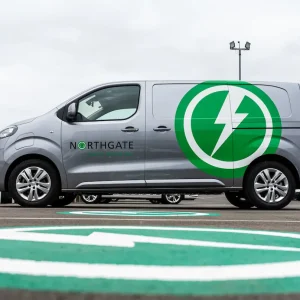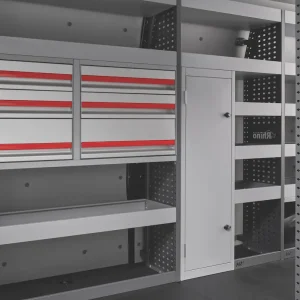Lethal Potential
“That small tool or fitting that you always meant to tidy away could be as lethal as a bullet if it hits the back of your head,” warns Chris Jones, UK sales director at load area racking specialist Sortimo.
Nor will a home-made racking system built to house all the items you have to cart around with you be of much help. Odds are that it will break loose along with its contents if the driver has to slam on the anchors heavily, and do even more damage. OK, installing a bulkhead will help defend the cab’s occupants from all this flying debris, but even the most solidly-constructed bulkheads aren’t bomb-proof.
The reality is that it makes far more sense to have all your tools and parts contained in a professionally designed load area storage system that is unlikely to come adrift in a collision because it’s been properly crash-tested. The duty of care you owe yourself and your employees should give you every incentive to go this route.
Crash-Testing
More and more racking makers are subjecting their products to crash-testing, Sortimo among them. “We loaded the body of a van fitted with one of our racking systems onto a sled at the Transport Research Laboratory at Crowthorne in Berkshire,” explains Jones. “Itself weighing 150kg, the racking was laden with sandbags weighing approximately 365kg and the sled was accelerated to 31mph before crashing into a barrier.
“Although the vehicle fittings were distorted in the direction of travel, the load remained in place,” he continues. “The driver and passenger would have survived as the special Sortimo floor installation transferred the impact forces into the van body itself.
“A second sled test was then carried out using home-made racking installed in an identical van body with a total weight of 446kg for the racking and sandbags,” says Jones. “As the body hit the barrier it all shot forwards, filling the cab space. Anybody sitting there would probably have been killed.”
Not to be outdone, Modul-System has had its products crash-tested extensively at Volvo’s car safety centre at Gothenburg in Sweden. Bri-Stor has had similar tests carried out in the UK at the Motor Industry Research Association’s centre near Nuneaton and the Millbrook Proving Ground in Bedfordshire. “In addition we’ve got our own laboratory at our 25-acre headquarters in Hixon in Staffordshire,” says commercial director, Richard Issitt.
Weight Matters
 As well as crash-testing their products, manufacturers of racking, shelving, drawer units and drawers and cabinets are doing all they can to make them lighter, but without compromising their strength. Sortimo’s Globelyst equipment, for instance, employs an aluminium framework said to cut weight by from 20 to 30 per cent.
As well as crash-testing their products, manufacturers of racking, shelving, drawer units and drawers and cabinets are doing all they can to make them lighter, but without compromising their strength. Sortimo’s Globelyst equipment, for instance, employs an aluminium framework said to cut weight by from 20 to 30 per cent.
In addition to employing strong but lightweight composite materials, Bri-Stor is making extensive use of high-strength special steels from Scandinavia says Issitt. They’re pricey but their strength means that less steel can be used, cutting the weight of the company’s products.
“It makes them almost as light as they would be if we used aluminium instead,” he says. “However, we’ve had to install new equipment to handle these steels,” he continues. “As a consequence we’ve invested £5m in our factory over the past two years.”
Alongside testing their onboard systems and cutting their weight, racking makers have been adding new products to their ranges.
New Products
 Sortimo has come up with L-BOXX. It describes a family of polymer tool boxes of varying sizes that can be carried around in a van housed inside a specially-designed Globelyst unit and that can be clipped to each other.
Sortimo has come up with L-BOXX. It describes a family of polymer tool boxes of varying sizes that can be carried around in a van housed inside a specially-designed Globelyst unit and that can be clipped to each other.
If a technician has to tackle a demanding task that requires two or three different sets of tools, then all he needs to do is clip together the relevant boxes and clip them to the underside of his L-BOXX tool carrier. If there are too many to carry, then the stack of boxes can be placed on a sack trolley and wheeled to the job concerned.
Elsewhere, Modul-System has come up with racking packages 200mm deep designed with light vans such as Citroën’s Nemo and Renault’s Kangoo Compact in mind. They typically weigh less than 20kg, which means that they don’t eat significantly into a small van’s modest payload capacity.
Again aiming to save weight, Edstrom has devised a tool case designed to house small parts that is made of plastic, complete with a transparent lid. Its predecessor was made of steel, but Edstrom reckons that its new offering is just as tough.
Organisation
 Onboard storage units make it easier for a driver to see exactly what he’s got on board. They make it less likely that he’ll have to drive back to the depot to collect a vital missing tool, losing valuable time, because he’ll easily spot that he hasn’t got it with him before he departs for his first job of the day.
Onboard storage units make it easier for a driver to see exactly what he’s got on board. They make it less likely that he’ll have to drive back to the depot to collect a vital missing tool, losing valuable time, because he’ll easily spot that he hasn’t got it with him before he departs for his first job of the day.
Tools and parts kept safely in drawers and cabinets are less likely to be lost or damaged. They’re less likely to be stolen too, because those drawers and cabinets can be locked. What’s more, the drawers will be designed in such a way that they won’t fly open every time the driver takes a bend a bit too quickly.
Legal
Sensibly-designed onboard storage packages should also help protect the van’s owner and driver from the risk of overloading, and a possible prosecution. When all the tools and parts are safely stowed, they will know precisely how much weight they’ve got on board. With everything strewn all over the cargo bed, they won’t be anywhere near as sure. Bear in mind that in a recent court case a van operator found guilty of a gross overload ended up paying out around £7,500 in fines and costs.
Price Point
Quality racking does not come cheap. A storage system running down each side of the load area of a short-wheelbase Vauxhall Vivaro can easily set you back £1,000.
It is worth noting, however, that it may be possible to remove it and install it in another van of similar size when the first van comes up for disposal.
Roof Storage
 As well as the cargo area the roof can be used to transport items — Trukrax is one company that can supply a wide range of roof racks and related items designed for commercial applications — although there are limits to how much weight it can support. Clambering up onto the top of a high roof van to unload a ladder is an unwise working practice — if you slip and fall, you could be seriously injured — so a number of firms supply racks that allow the ladder to be lowered down the side or rear of the vehicle while the employee doing the lowering remains safely on the ground.
As well as the cargo area the roof can be used to transport items — Trukrax is one company that can supply a wide range of roof racks and related items designed for commercial applications — although there are limits to how much weight it can support. Clambering up onto the top of a high roof van to unload a ladder is an unwise working practice — if you slip and fall, you could be seriously injured — so a number of firms supply racks that allow the ladder to be lowered down the side or rear of the vehicle while the employee doing the lowering remains safely on the ground.
At Your Service
All of the efforts made to introduce newer, lighter, and safer products will count for very little if the manufacturer concerned cannot provide the end-user with comprehensive support. Sortimo has recently set up a facility at Warrington capable of taking up to 300 vans straight from the production line, carrying out a pre-delivery inspection, racking them out and applying livery too.
“It also caters for one-man one-van businesses,” stresses Jones. Bri-Stor can offer the same level of service for operators big and small at Hixon.
Fleet Focus
Boosting the service it offers is something Bott is concentrating on, and is working in partnership with Vansys to provide the sort of solutions for small businesses that up until now have only been available to big fleet operators. A while back Bott expanded its site at Bude in Cornwall, installing a new showroom plus a training centre.
Bott’s portfolio of fleet clients includes Home Delivery Network. It’s fitted over 500 new Vauxhall Movanos going into service with the parcels delivery specialist with load area linings comprising polypropylene — again with weight-saving in mind — and 12mm non-slip-surfaced plywood.
Tracking which allows certain items to be held in place while being transported has been installed while the driver’s door and the rear doors have been equipped with restraint straps. Reversing sensors have been fitted and Bott has applied the livery.
 A more specialised project has had Bott kitting out seven support vehicles — three Ford Transits and four Ford Rangers — for use by Sembcorp UK’s Protection Group. It provides emergency cover for industrial sites on Teeside.
A more specialised project has had Bott kitting out seven support vehicles — three Ford Transits and four Ford Rangers — for use by Sembcorp UK’s Protection Group. It provides emergency cover for industrial sites on Teeside.
The Transits have been fitted with a forward compartment that houses breathing and resuscitation apparatus while the rear compartment contains tools along with equipment used to corral spillages and degrease contaminated areas. Both compartments feature shelving.
Each of the Rangers boasts a lockable drawer unit beneath the cargo floor that houses equipment used to help rescue people trapped high up on industrial installations. With eight appliances, Sembcorp runs one of the largest privately owned industrial fire brigades in the UK; just the people you need if your factory bursts into flames one night.
Verdict
There is no shortage of internal storage solutions available for light commercials and a bespoke system could well turn out to be the best investment you ever made, giving many years of service.

 A deadly cocktail of tools, parts, bits of timber and nameless pieces of junk occupies the load area of all too many vans. Stacked higgledy-piggledy, if it all shoots forward under heavy braking, and no bulkhead has been fitted, then the driver will cop for the lot. At best, he’ll be badly injured. At worst, he could be killed.
A deadly cocktail of tools, parts, bits of timber and nameless pieces of junk occupies the load area of all too many vans. Stacked higgledy-piggledy, if it all shoots forward under heavy braking, and no bulkhead has been fitted, then the driver will cop for the lot. At best, he’ll be badly injured. At worst, he could be killed.



